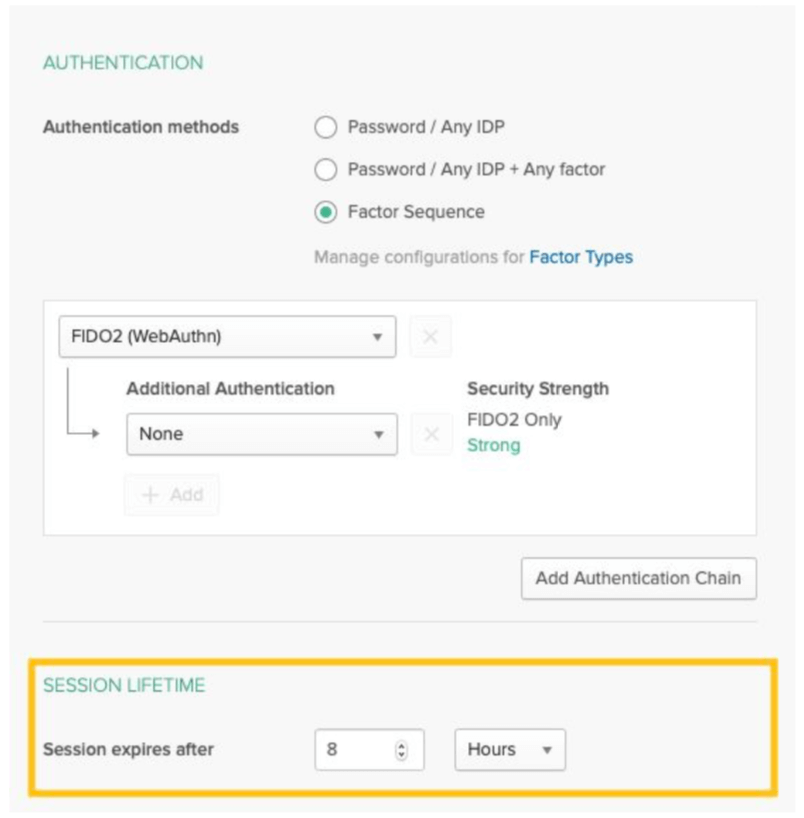
8 Steps for Effectively Deploying MFA
The value of MFA
Multi-factor authentication (MFA) has never been more important. With the growing number of data breaches and cybersecurity threats—and the steep financial and reputational costs that come with them—organizations need to prioritize MFA deployment for their workforce and customers alike. Not doing so could spell disaster; an invitation for bad actors to compromise accounts and breach your systems.
Adopting modern MFA means implementing a secure, simple, and context-aware solution that ensures that only the right people have access to the right resources. It adds a layer of security, giving your security team, your employees, and your customers peace of mind. Unfortunately, while the benefits are clear, implementing MFA can be a complex project.
In our Multi-factor Authentication Deployment Guide, we’ve outlined eight steps that you can take to better enable your MFA deployment:
- Educate your users
- Consider your MFA policies
- Plan and provide for a variety of access needs
- Think twice about using SMS for OTP
- Check compliance requirements carefully
- Plan for lost devices
- Plan to deploy MFA to remote workers
- Phase your deployment: be prepared to review and revise
In this eBook, we’ll take a deeper dive into each of these elements, giving you tactical advice and best practices for how to implement each step as you get ready to roll out Okta MFA.
1. Educate your users
As you get ready to deploy MFA across your organization, you may receive pushback from users that view this security feature as an inconvenience. To get ahead of this feedback, it’s important to be proactive and transparent about the changes you have planned—especially any potential impacts to user experience. We recommend doing a combination of the following:
a. Use email communication
This will likely be the most effective method for keeping users informed and educating them around MFA. At Okta, we’ve developed a set of end-user training materials specific to MFA, which are available for sharing with your colleagues.
b. Allow employees to reach out to IT via a messaging app
Modern workforce messaging apps allow you to create company-wide groups so that employees can exchange ideas and ask for help. On Slack, for example, you can create a channel and dedicate it to a specific topic. Consider creating a group that allows your employees to ask IT team members for help during and after your MFA rollout.
Having buy-in across the organization is vital to the success of a new feature. Ensure that your employees understand how they can help better secure your organization by enabling MFA on their account. Ultimately, they can play a key role in keeping your company safe.
2. Consider your MFA policies
Before you roll out MFA, you’ll have the opportunity to set policies that make sense for your workforce. For instance, instead of having users constantly interrupted and prompted for a second factor, you can define MFA policies that account for the risk associated with each login event.
The types of policies you deploy will vary depending on your industry or the sensitivity of the data your users have access to. In some cases—like at a financial institution—it may be necessary to prompt users for MFA every couple of hours. In others, users may only need to authenticate via MFA when accessing critical applications.
To help guide your policy decisions, we’ve developed some general guidelines:
Prompt users for MFA every eight to 12 hours
To ensure high assurance sessions, consider setting the session time in Okta to between eight to 12 hours and prompt users for MFA when the session expires. While this may seem rigorous, it’s important that your MFA solution is able to continually validate that users are who they say they are when logging in.
Setting up session-based MFA policies in Okta
In the admin console, go to Security > Authentication > Sign-On. When editing individual rules, you’ll see an option for Session Lifetime.

Combine Risk-Based Authentication with your factor choice
While you should consider enforcing MFA on every login, in some cases you may be comfortable with less secure factors for low-risk logins. This can be done with Risk-Based Authentication. In these low-risk instances, you could require a password and SMS OTP. Meanwhile, in medium-risk logins, requiring a stronger factor like Okta Verify Push or WebAuthn is preferred. These stronger factors will also help you set a great foundation to eventually go passwordless.
Combine Risk-Based Authentication with a specific factor type in Okta
In the Okta admin console, go to Security > Authentication > Sign-On.
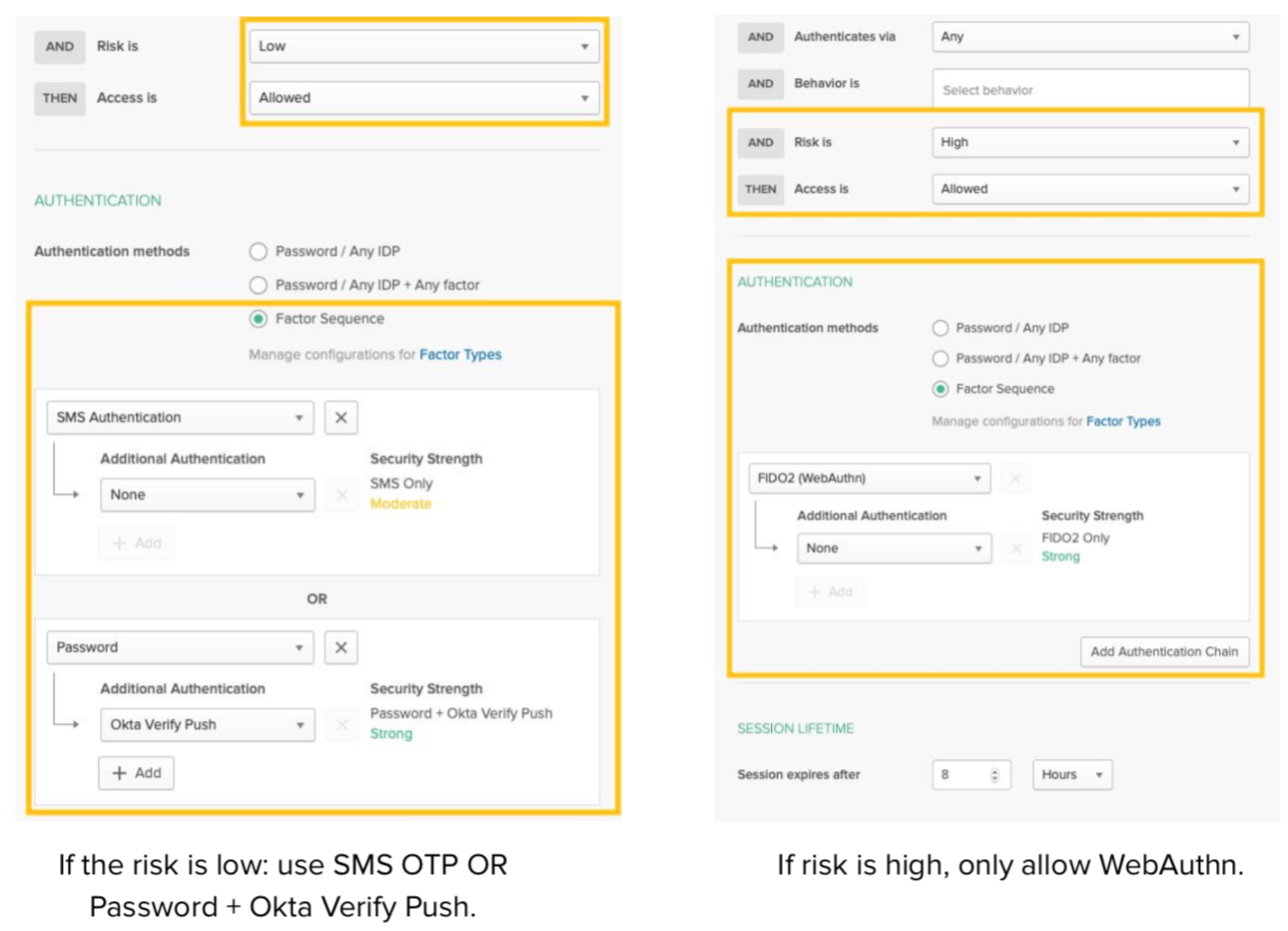
Bonus deployment tip for Risk-Based Authentication
If you’d like to test Risk-based Authentication and track entries in Syslog using a phased approach, but do not want to impact the end user experience when modifying policies, try the following:
-
Choose the “high”, “medium”, or “low” options in the drop down, but do not modify any other policy settings
-
You can do this for each rule within your sign-on policies, or add new rules with the risk level settings that mock the existing end user experience
You can choose to do this for a subset of users initially to track the “high”, “medium”, “low” Syslog entries, without modifying end user experience based on the risk level. When ready, you can modify the policy rules to also change the access response based on risk level.
3. Plan and provide for a variety of access needs
It’s important that you plan your MFA deployment to support a range of factor needs. Different user groups may require different factor options. We suggest the following breakdown:
| Group | Factors |
|---|---|
|
Most full time employees |
|
|
Executives with access to sensitive data |
|
|
Partners accessing resources in your Okta tenant |
|
|
Call center employees that cannot bring their phones |
|
|
Temporary interns or contractors |
|
Thankfully, there are a variety of factor options available in Okta, and using MFA you can enable specific factor types for different groups. Here are some MFA deployment tips:
WebAuthn allows you to enroll multiple devices
When you have WebAuthn enabled in Okta, users can enroll up to five devices on their account. If the user misplaces a device, they can use another WebAuthn device as a backup. For example, here’s what an individual’s account at Okta might look like (“Security Key or Biometric Authenticator” is the WebAuthn factor type):
You’ll also notice we don’t allow SMS OTP as a factor.
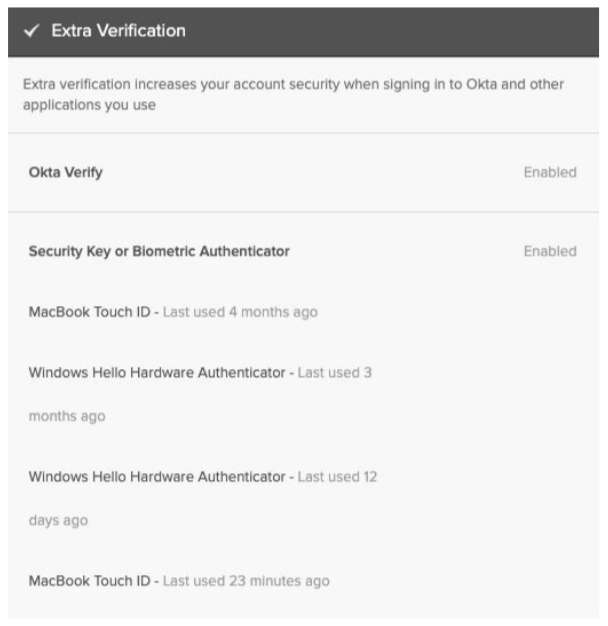
Enable Okta Verify OTP for partners
Okta Verify OTP is a free factor available to all customers and increases the fidelity of partner logins.
Utilize Okta HealthInsight to help you identify where weak factors are enabled
If you are already a long-time user of Okta’s MFA products, you may already have a number of factor enrollment policies that are hard to keep track of. Okta HealthInsight is available to all of our customers and helps easily identify which policies allow for weak factor types. You can find Okta HealthInsight in your admin console under Security > HealthInsight.
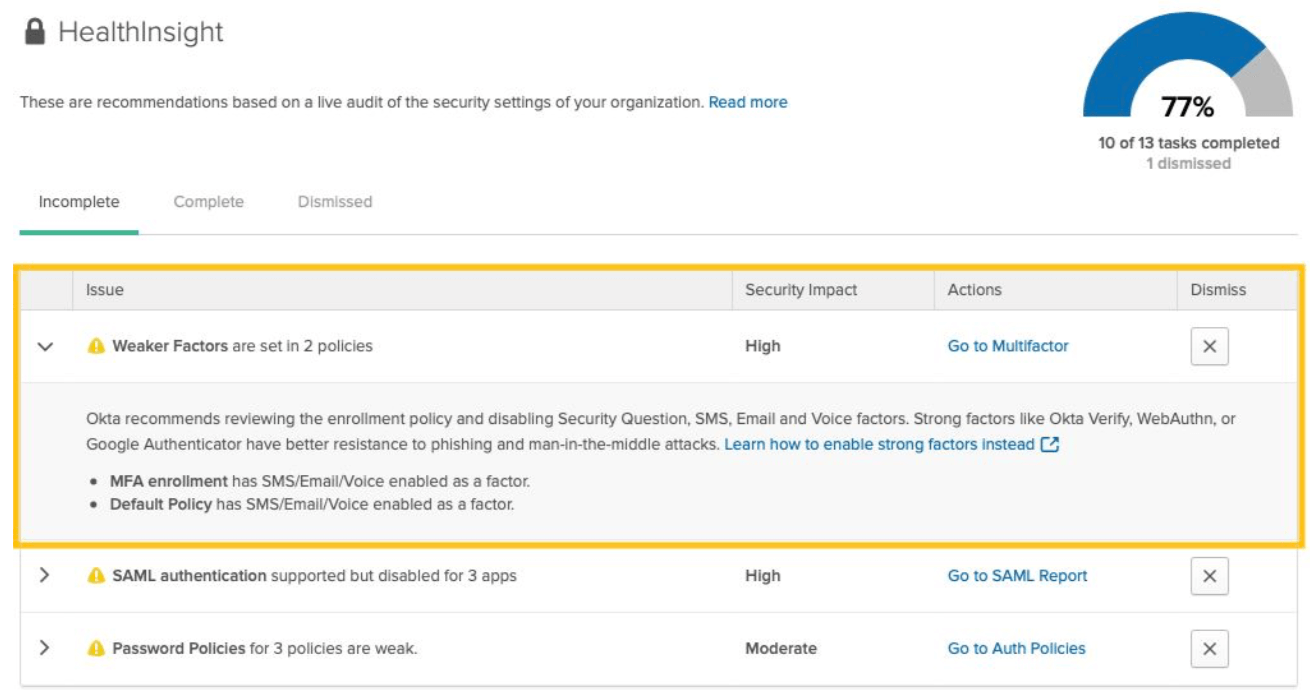
Bonus deployment tip to secure accounts
Enable Okta ThreatInsight. This tool detects suspicious IPs accessing your org and proactively blocks those IPs before the authentication process, helping to prevent both account lockouts and account takeovers. To learn more, read our Okta ThreatInsight whitepaper.
Ensure users have a backup factor available
When your users are able to easily reset their factors and use an alternate factor in case their primary becomes unavailable, your IT helpdesk will thank you. Your users will also appreciate that they can get quickly up and running on their own.
Choose factors for your user groups in Okta
Change your factor enrollment policies in the Okta admin console, under Security > Multi-factor > Factor Enrollment.
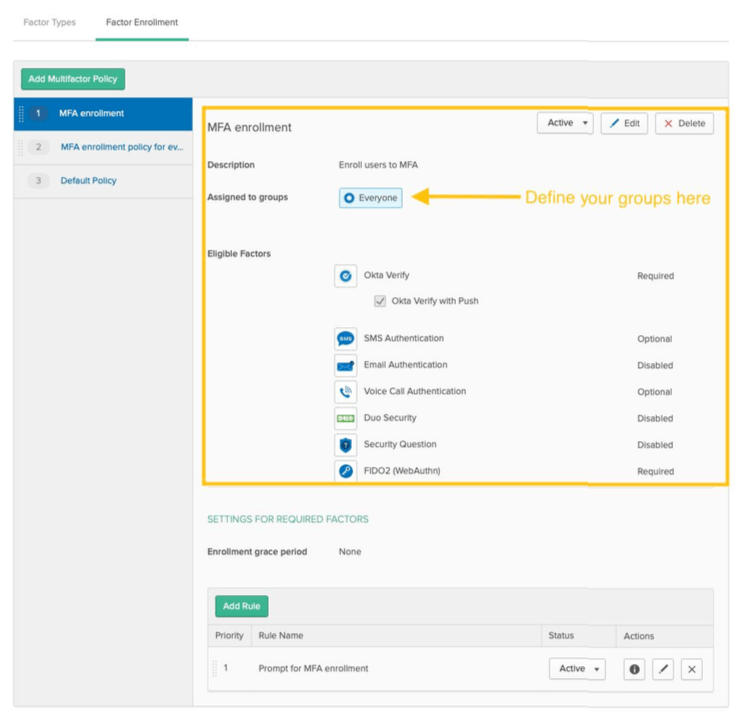
Bonus deployment tip for managing MFA and sign on policies
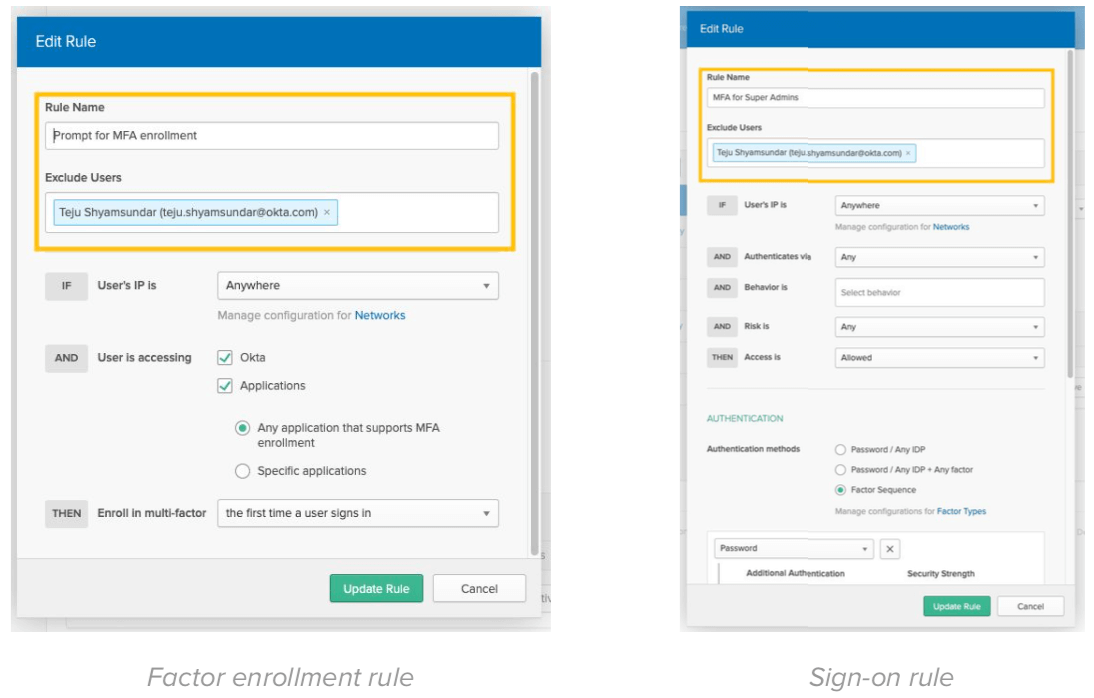
4. Think twice about using SMS for OTP
SMS is familiar to your users and easy to rollout as a factor. With the prevalence of cell phones and tablets, it’s easily accessible and has become a common communications channel for OTP delivery. Up until recently, SMS has generally been assumed to be “secure enough” for this purpose. Now, SMS has proven to be an insecure method for securing access to accounts. Common issues include SIM swapping or hacking, lost devices, and social engineering attacks like phishing.
Instead of using SMS for your OTP purposes, we suggest that you replace it with more secure factor types like Okta Verify Push or WebAuthn. Here are a couple of tips for removing SMS OTP.
Utilize the MFA usage report
You can utilize the MFA usage report to understand which users continue to log into Okta using SMS OTP. This report will include the enrollment date as well as the last used date for every user. The report can be downloaded as a CSV to further analyze MFA usage. It’s available under Reports > Multi-factor Authentication.
Enable WebAuthn in your org
You can start by enabling WebAuthn as an optional factor type, and communicate this to your users via email so that they know it’s available. Hardware support for WebAuthn includes the following:
Off-device/roaming authenticators
These are WebAuthn-supported factors that are not built into the hardware (computer/phone).
On-device authenticators/platform authenticators
These are WebAuthn-supported factors that are built into the hardware (computer/phone).
-
Windows Hello on Windows 10 1903 and later
-
Touch ID on MacBook
-
Fingerprint on Android 7.0+
Support for WebAuthn is dependent on the web app updating their authentication process to support the WebAuthn API, browser support, OS support, and hardware support. This may seem overwhelming, but thankfully, many operating systems, devices, and browsers already support WebAuthn. While consumer apps are still in the process of adopting this standard, if you’re using an enterprise-grade authentication provider like Okta to secure access for the workforce, it’s likely you’ll be able to use WebAuthn with that provider.
5. Check compliance requirements carefully
IT compliance standards such as the Payment Card Industry Data Security Standard (PCI DSS), the Sarbanes-Oxley Act (SOX), and the Health Information Portability and Accountability Act (HIPAA) mandate strong user authentication controls. These standards are usually strong motivators for an MFA deployment.
If you do have compliance requirements to meet, ensure you have a detailed understanding of what they entail so that you can correctly tailor configuration policies to them. We suggest taking the following steps:
Make documentation a required part of your implementation process
PCI and HIPAA require strong authentication, with at least two authentication methods out of these three categories:
-
Something you know
-
Something you have
-
Something you are
By requiring Okta MFA, you can meet these requirements. While SOX is less focused on the technology itself, you will still need to prove your organization’s financial data is secure in order to pass their audit. Ensure that you have documented your configuration for others to reference in the future in case of any changes in requirements.
Learn about how Okta can help you meet compliance requirements
At Okta, we’ve done a lot of work to ensure that our platform meets various requirements from different regulations, and in some cases our customers can inherit compliance with certain elements.
Okta’s HIPAA Compliant cell is specifically designed to meet HIPAA requirements for service providers. From end-to-end encryption of data to dedicated hardware, Okta enables organizations to manage employee, vendor, and patient identities with a single, secure solution.
Okta can also help you comply with PCI DSS 3.2, an information security standard for organizations that store, process, or transmit credit card data. Among other controls, this standard requires strong MFA to authenticate access to servers and software handling credit card data, strong encryption, and the ability to ensure that only authorized employees have access to credit card data.
Okta’s Universal Directory, Lifecycle Management, and Adaptive MFA solutions enable customers to easily implement these controls within the cloud and the on-prem components of their Cardholder Data Environments, simplifying compliance to the PCI standard and reducing compliance costs. With the release of Okta's PCI-DSS Attestation of Compliance (AOC), customers are no longer required to demonstrate to auditors how Okta is out of scope to their PCI environment. They can directly leverage the strong protections for identity that Okta offers within their own compliance programs.
You can enable FIPS-mode encryption for Okta Verify. This means that passcodes and push notifications generated by Okta Verify on the following device versions are FIPS 140-2, Level 1 compliant:
-
All versions of Okta Verify on Apple iOS 7 and higher
-
Okta Verify versions 4.4.0 and higher on Android 6 and higher
For more information on all Okta’s service certifications, see Okta Trust.
6. Plan for lost devices
Anything a user has, they can lose. As such, you should always have a plan for lost and/or stolen devices and security keys. Ideally, in such a case, users should be able to access their account with a backup factor and disassociate a lost device or key from their account. This will minimize the probability of account compromise. With this in mind, there are a couple of ways that you can plan for any instance where your user loses their authentication hardware.
Ensure users have a backup factor available
If your users are able to easily reset their factors and use an alternate factor type in case their primary one becomes unavailable, your IT helpdesk will thank you. Your users will also appreciate that they can solve a potential account compromise on their own.
Choose different factor types in Okta
You can select the factors available to different user groups using Okta’s factor enrollment policies in the admin console, under Security > Multi-factor > Factor Enrollment.

Communicate the features of WebAuthn
If you are using WebAuthn, your users can enrol multiple devices—and they should be aware of this feature. Okta allows you to register up to 5 WebAuthn factors to an account.
Disassociate lost/stolen factors from an account
This process can be either admin-initiated or user-initiated, but in a scenario where a user can no longer recover a factor, it’s important to disassociate that factor type from their account. That way, if the device ends up in the hands of an attacker, they won’t be able to access the user’s account.

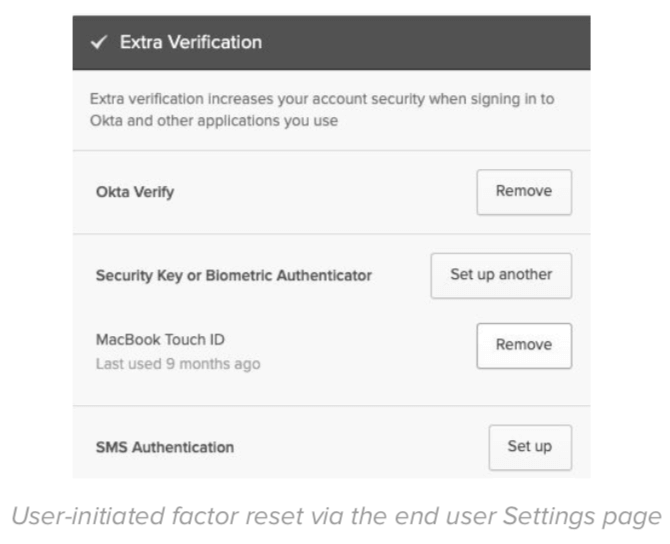
Bonus deployment tip for factor reset
These reset actions are also available via our Factors API. Some organizations create lightweight apps that call these APIs so that users do not need to login to the Okta dashboard to reset their factor.
7. Plan to deploy MFA to remote workers
Optimizing IT processes to support remote employees is now more critical than ever. Traditionally, employees go through a full in-person onboarding process where they set up their device and account (including MFA) with the help of IT. However, as more employees work from home, it’s important to have a streamlined process for getting users onboarded from afar. Here are some of the things you can do to get this right:
Utilize the secondary email attribute in Okta during the pre-hire process
You may have noticed a field called “secondary email address” in Universal Directory. It’s a good idea to create users before their official start date. This can be done manually, via directory integrations or HR-as-a-Master integrations, and ensures that anyone on your IT/onboarding team can communicate with the user before Day 1.
Use productivity tools (including MFA) to help with remote onboarding
Having to remotely onboard employees has pushed us to be more creative around this process. While you could just ship your new employees a laptop and send them an email with setup steps, you may also want to consider a more interactive onboarding experience. One example is Zoom, an app that saw 110% growth between February and March 2020, which can be used to guide users through the process of setting up their device, account, and MFA.
Deploy intelligent access policies using Adaptive MFA
It’s no secret that attackers have been taking advantage of the chaos around the COVID-19 pandemic to launch a flood of phishing and identity attacks. Barracuda researchers have observed a 667% increase in spear-phishing attacks since the end of February 2020 and the FBI has even issued a warning about an increase in fraud schemes due to the pandemic.
This means we all need to stay ahead of threats. Creating policies using Okta’s Adaptive MFA is a great way to do that.
-
Enable Okta ThreatInsight on your org to proactively prevent account lockout and account takeover from suspicious IP addresses.
-
If there are specific locations/regions you know that no employees should be accessing apps from, use Okta’s country-based dynamic zones to deny access from those locations.
-
-
Create policies for behavior detection—especially new device logins. Set your authentication policy to always prompt for MFA on new device logins.
-
Bonus deployment tip to enforce adaptive policies
Did you know you can combine Risk-Based Authentication with Okta Verify to protect against phishing attacks? When Okta detects a high-risk login, end users are presented a Review button in Okta Verify allowing them to review details about the authentication attempt. End users can then tap either Yes, It's Me to access their Okta account after satisfying a simple verification challenge or No, It's Not Me to deny the authentication attempt.
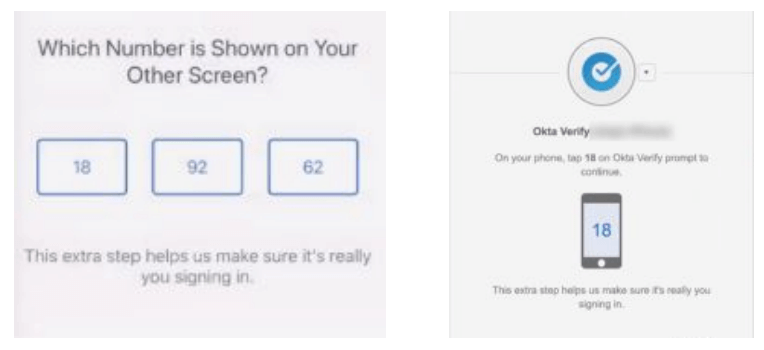
You can learn more about this feature here. You can also enable the feature on your org via the self service feature manager, Settings > Features. Look for Phishing Resistant Okta Verify Push.

8. Phase your deployment: Be prepared to review and revise
This is true for any technology in your environment: you should be prepared to modify policy configurations and adapt to new business requirements as they emerge. Get comfortable with our auditing functionality (via Syslog) early in the process—it will be invaluable for troubleshooting and adjusting policy configuration. Once you’ve deployed MFA to your users, use auditing tools to spot check adoption and use. Deploying a mechanism that allows users to provide feedback can also be useful—while users may not always take the time to provide written feedback, an audit trail gives you some visibility into what they experienced.
Here’s one feature that we’ve developed to help users have more insight into their account activity.
UserInsight
Userinsight alerts users via email when suspicious activities like an MFA factor enrollment or password change is detected on their account. From there, the user has the opportunity to report the activity to their IT admins if they don’t recognize it.
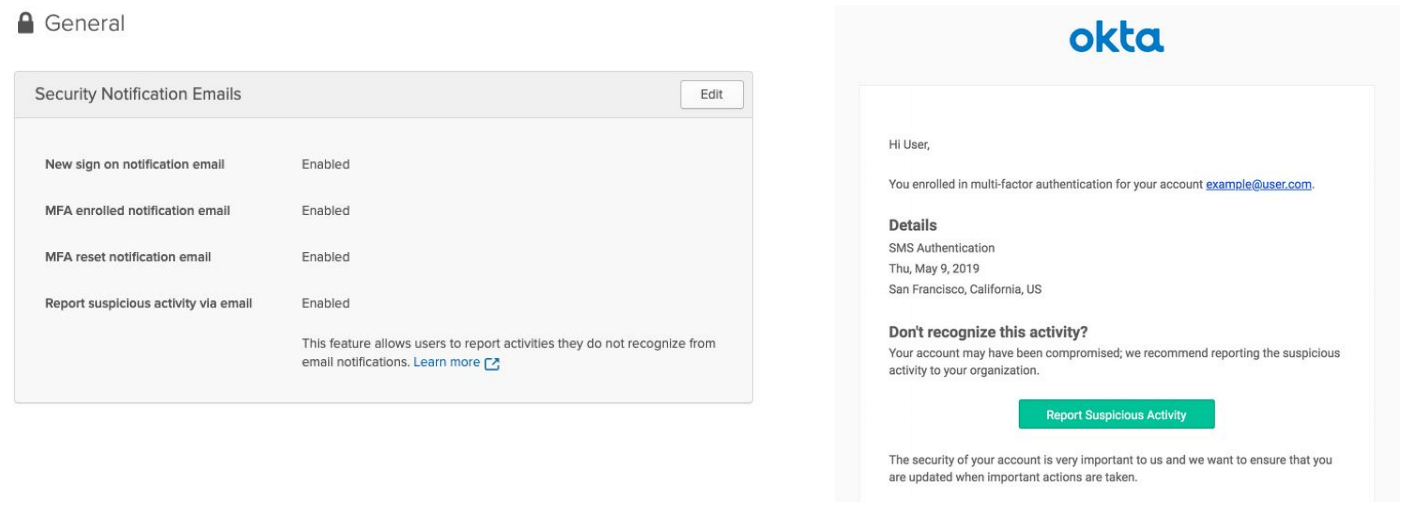
Today’s digital environment and growing levels of security risks make it indispensable for companies to deploy adaptive multi-factor authentication. This context-aware tool makes it easier for you to secure your people—the new perimeter—and engage your users in actively protecting your resources and data. With these eight steps, you’ll be well on your way to a successful MFA deployment that secures your users, without compromising their productivity.
If you have read this far, you’re ready to start deploying MFA!
For more information on how to get started with deploying Okta Adaptive MFA, watch our demo.

